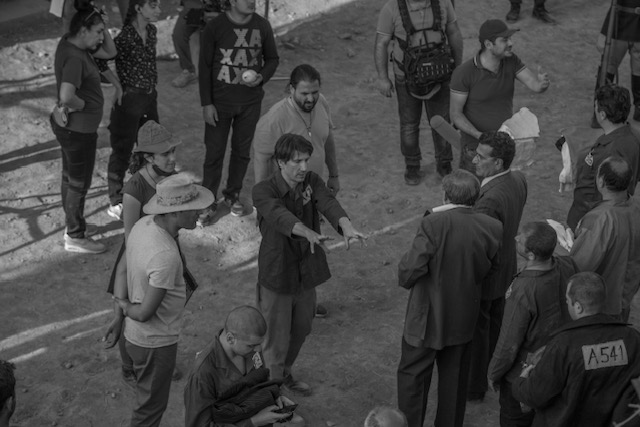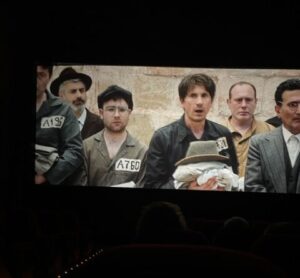
Many people may not know about Michael Goorjian. The Emmy Award-winning Armenian-American has garnered a commendable repertoire in the film and television industry. He is best known for his role as Justin in the hit 1990s television series Party of Five, playing opposite Neve Campbell, and has shared the screen with Hollywood legends including Robert De Niro, Kirk Douglas, Michelle Pfeiffer, Morgan Freeman and Betty White. Yet for the humble 52-year-old San Francisco Bay area native, the most important role of his decades-long career is bringing to life the new highly-acclaimed original film Amerikatsi.
In a recent candid interview with the Weekly, Goorjian opened up about the movie’s inspiration, his life changing bond with his Armenian heritage, and what led him to make the film in Armenia so many years after first visiting.
“As a filmmaker, I found in Armenia the kind of filmmaking I live for. I like to be involved in projects I care about. Despite some concerns about infrastructure, what wasn’t there are all the limitations and regulations that exist in Hollywood. That’s what independent film is all about,” he said.
He reminisced about the rise of indie films in the 1990s and how he began his career making short films with friends. He also said that he worked with different types of directors who were lesser known but would eventually help him find his own style.
Growing up in Northern California, Goorjian wasn’t particularly active in the Armenian community. It wasn’t until he did a reading for an April 24 Armenian Genocide commemoration that he began to connect to his Armenian roots. However, it was his 2006 trip to Armenia, when the movie Illusion, in which he played opposite Kirk Douglas, was screening in Yerevan, that evoked his desire to connect more deeply with his Armenian heritage.
Goorjian spent hours at dining tables in Armenia, toasting with friends with song and dance, which he includes in scenes throughout the film. “The Armenian side of culture isn’t just to eat and run the way it is in America. In Armenia, they celebrate life at the table,” he shared.

“I think part of our cultural identity is continually asking ourselves what it means to be Armenian. I’ve traveled a lot, but there was something about Armenia that felt different. I felt it was more me. From that point on, I became more and more interested in attending Armenian events and eventually writing the script for [Amerikatsi], at the suggestion of a journalist friend,” he explained.
Though the film is fictional, it includes actual events that took place when Armenians repatriated to Soviet Armenia in the 1940s. He dedicates it to his paternal grandfather Manoog, a survivor of the 1909 Ottoman massacres, similar to how the film’s protagonist Charlie Bakhchinyan survives the Armenian Genocide.
Goorjian was in his early teens when his grandfather passed away, yet the wisdom he passed on still plays an integral role in the actor’s career. His fondest childhood memories are Sunday visits to his grandfather’s house and a young boy’s joy in picking out candy from jars tucked away in a pantry.
Born Michael Antranig Goorjian, with a Scottish-American mother and Armenian father, he grew up in a happy home where the Armenian Genocide and the horrors his ancestors suffered weren’t heavily discussed.
“The character I play shares the same attitude my grandfather had towards life. I remember his essence more than anything else. He told me it would be easy for me to make friends. Whatever he told me came true. I imagine he would be proud of the film because it’s about showing when you go through hardships in life, those become less important than being happy,” said an emotional Goorjian.

It took him just one month to write the first draft of the script for Amerikatsi, which translates as “of American heritage” in Armenian. Goorjian spent time researching Soviet-era Armenia and pulled in hundreds of different true stories to write it. The film features local and diaspora talent, with Arman Nishanian as one of the producers. Goorjian plays Charlie, the lead character, while well-known Armenian actors Nelli Uvarova and Hovik Keuchkerian play the characters of Sona and Tigran, respectively. The film took five years to complete with the pandemic lockdown hindering production, wrapping in July not long before the start of the 2020 Artsakh War.

The end result intertwines humor and raw emotions with subtle shifts in tone to tell a story from a chapter in Armenia’s history that has never been told on the big screen. In many ways, Amerikatsi pays homage not only to Armenia’s unique culture but to actors and directors who seek vast creativity and artistic freedom.
“We are used to films being generic, but I’ve always enjoyed films that play with tone, and a lot of what took place during the Soviet Union were so absurd, the only way to deal with it was through humor,” said Goorjian.
The movie has garnered worldwide attention and praise. It was just selected as Armenia’s official entry for the Oscars international film competition. If nominated, it will be a first for Armenia.
“Up until this point, Armenia didn’t think it had a legitimate chance to win. With all the politics involved, we are competing against much bigger productions, especially in Europe, that have millions of dollars in budget,” he said.

Amerikatsi opened this month in select theaters nationwide following the movie’s Los Angeles premier. The nonprofit charitable organization Knights and Daughters of Vartan NJ/NY Chapter hosted its New Jersey screening on September 14 at Westwood Cinemas and presented Goorjian with an honorary achievement award for the film.
“On behalf of the organization, we were honored to present Michael with an award we share with our brothers and sisters who make a lasting impact in the Armenian community. I had the opportunity to spend a brief time with him to coordinate the screening and found that he has the unique ability to draw in people with his humble approach and sensitivity to others. In regards to the movie, it takes true talent to bring out such a range of emotions. It was so uplifting,” said Nina Terzian, lead organizer of the event.
Prior to the screening, Goorjian met with eager fans during a meet-and-greet followed by a post-film Q & A session, when audience members had the opportunity to discuss the film with the director. For many of them, the film represented the stories of what their own relatives endured in Soviet Armenia.
Nerses Tavitian was born and raised in Romania, which was under communist rule in the 1940s. He watched the film thinking of his paternal aunt and her family, who repatriated to Armenia from Romania in 1948 in hopes of a better life.
“What was included in the film was almost exactly what happened to our family, and it brought me to the reality of all the stories I’ve been told of how Armenians suffered under the communist regime. Even my father’s close friend, who was a member of ARF, was sent to Siberia,” Tavitian said.

Pauline Pechakjian, a graduate student from the University of California’s history department, saw the film in Los Angeles. In 2019, she wrote her master’s thesis on the topic of “repatriation” to Soviet Armenia between 1946-1949 entitled, “‘The Akhpars’: A Social History of the Mass Migration of Diaspora Armenians to Soviet Armenia.”
“As we see with the film, Armenians who had that strong connection to their heritage ultimately repatriated and found themselves arrested, exiled or even killed for displays of ‘Armenianness’ in the ASSR (Armenian Soviet Socialist Republic),” she explained, while noting similarities between her research findings and the accuracy of the film.
“In terms of what’s going on in Artsakh right now, there are many ways Armenians can help [tell our story] and it’s not always the same way. What I realized is we can bring more attention towards Armenia through art”
“Despite all of the loss and trauma experienced by ‘repatriates,’ people feel nostalgic for a time when they lived among other Armenians, where they were able to raise their families in an entirely Armenian community. The love of homeland overrides all other negative feelings and experiences for a large number of Armenians,” she added.
Goorjian said he made this film to reach people outside the Armenian community and tell a different part of their history. Yet above all else, it’s a human-interest story – of betrayal, longing for a homeland, survival and strength, and family and friends gathering together.
“In terms of what’s going on in Artsakh right now, there are many ways Armenians can help [tell our story] and it’s not always the same way. What I realized is we can bring more attention towards Armenia through art,” Goorjian said.

Rebecca Taylor, an Italian-American, was at the New Jersey screening of the film and has close ties with the Armenian community through her childhood Armenian friend. “I wasn’t aware about the aftermath [of the Armenian Genocide] and how the Armenian people were so affected by others and continue to go through hardships. I was able to learn so much more about their history, which was so well depicted throughout the movie,” she said.
“That’s the role of an artist, to show who we really are and what’s beautiful about the Armenian culture. We need to expand what they think beyond just the stereotypes and to share about the Genocide, which is important but only a facet of who we are. A friend of mine saw the film and talked about where the story goes and ends. He told me it made him want to be with family, and I would hope that would be a takeaway from the film, remembering that we have that,” Goorjian said.



It’s this kind of Western psyops – Americans good, Russians bad – brought tragedy to Armenia once again. Keep it up people, you are doing a wonderful job…